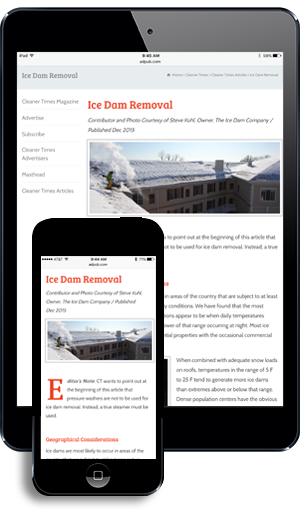
Maintaining Profits
by Diane M. Calabrese | Published October 2025

Break even? A must as soon as possible.
Once achieved, though, a break-even point is only the start. Make that the foundation. Profit is the first goal of any business. Maintaining profits is the second. How can the second goal be met in good times and challenging ones alike? Let’s start with some perspective from two veterans of our industry.
Businesses that maintain profits take a proactive approach to the fullest extent possible. There will be adverse economic times to come, even for a business that has not yet experienced them. An accurate understanding of cost centers in relation to income-producing lines allows a company to quickly make adjustments that can trim unnecessary expenses. The trimming simultaneously boosts profits.
Roy G. Chappell, the CEO of Chappell Supply and Equipment in Oklahoma City, OK, gives us one example of a detail that should be known to be proactive. Be sure to record the “incoming cost and freight duties on each invoice,” he says. “This way you keep your cost per item current with each shipment received.”
Backing up for a second, we realize the kind of forward-looking recordkeeping on all costs related to items and components received allows for a measured and fast response should unusual perturbations occur. Sudden tariff increases serve as an example.
There’s nothing easy about maintaining profits. The maintenance requires determination and constancy in the context of a clear goal.
Yes, we read endless news articles about Instagram and YouTube influencers who are swimming in profit. But it sometimes becomes reminiscent of the dot.com bubble – or much longer ago, tulip mania.
At some juncture, tangibles come into play. Machinery and tools must be made and operated and put to exacting uses, so infrastructure and societal networks do not fray. Thus, maintaining profits encompasses a realistic outlook. Is video production a core element of a business, or an ephemeral one?
The aphorism about the nuts-and-bolts of an endeavor applies nowhere better than in business. Influencers, for instance, may operate as sole proprietors. But if their profit is real and substantial, they must have a financial structure. They probably also require some help, even employees.
Employees add another dimension. In a solid business, employee compensation and retention are perennial considerations. The considerations constitute one of the most difficult parts of maintaining profits.
Adjusting cost of doing business whenever an employee receives a raise is essential to maintaining profits, explains Chappell. That’s because it’s not just the amount of a raise that must be factored into costs.
It may be a raise for one or several employees “that mounts up fast with Social Security, taxes, unemployment, etcetera,” says Chappell. It becomes a cost-center change that can be significant.
“When you give a raise, make it effective within 30 days,” says Chappell. And even during an interval when no payroll changes are being made, monitor the changes in indirect compensation (e.g., insurance) that spring up at less than 90-day intervals.
The 90-day interval should not be allowed to slip by the attention of an owner. “Reminder, you need to figure cost of doing business every 90 days – plus the different tariffs that are effective,” says Chappell.
“It is more important that tariffs alone can put your profit into a negative in 90 days or less,” explains Chappell. “Profits should be steady percentage with little movement up or down on the following: cost, duties, freight cost, cost of doing business.”
In the cost of doing business, think thoroughly. Include rent payment, building land, wages, and so on, says Chappell. Including the full cost of doing business in regular evaluations keeps a company nimble.
“If you are recalculating the cost of business every 90 days, [changes will be modest], explains Chappell. “What will make it change [more significantly] is the volume of business you do monthly.”
For example? If the average revenue per month is one million dollars and it drops for a month to $800,000, the costs per dollar of profit will increase. In other words, “your business costs will jump, and profits drop” for that month, explains Chappell.
“If your sales are $1,200,000 [for a month], your business costs will drop due to the higher volume of business,” says Chappell. “Therefore, profits will increase.”
The more complete the picture of cost centers, revenue streams and profit margins that a business has, the better it can plan. Since a critical part of planning is being prepared for the unexpected, precision in analysis undergirds efforts to maintain profits.
The precision also enables decisions to be made regarding shift in focus. Maintaining profits may mean additions or subtractions to a company.
More good advice
“One of the most effective steps we’ve taken is strengthening and diversifying recurring revenue streams, especially in service, parts, and detergents,” says R. Calvin Rasmussen, president of Royce Industries, L.C., which is headquartered in West Jordan, UT. “While equipment sales can ebb and flow with the economy, businesses still need their machines running.”
Be attuned to opportunities. And take them when feasible and appropriate.
“We’ve leaned into preventative maintenance programs, service contracts, equipment rentals, and bundled accessory/detergent solutions that keep customers engaged and equipment operational,” says Rasmusen. “These efforts not only build loyalty but also generate consistent, higher-margin revenue that helps stabilize profits during slower capital equipment cycles.”
Surely, even with the optimism that derives from readiness to make changes to a business, there are some difficult times. What is the most difficult part of maintaining profits even with the positive outlook we all strive to hold? “The hardest part is discipline, maintaining pricing integrity and not chasing volume at the expense of margin,” says Rasmussen.
“In tough times, it’s tempting to discount your way to the next deal. But we’ve learned — sometimes the hard way — that erosion in margin is much harder to recover from than a temporary dip in volume,” explains Rasmussen. “Staying focused on value, through quality equipment, service excellence, what sets our company apart from others and customer education, is critical to resisting that race to the bottom.”
Although Rasmussen does not define “race to the bottom”, we all have an inherent understanding of the phrase. We know that the race is one none of us wants to enter, a race that includes more than prices.
Quality in products and excellence are two facets of maintaining profits that merit repetition. Read any online discussions about products and companies. The same concerns, irrespective of the industry, appear repeatedly.
There’s no hope of maintaining profits if customers vanish or shrink in number. So, what do customers want? Isn’t it the lowest price?
Customers want a fair price. A price that is coupled with a quality product and/or service.
Customers also want the process of buying from a company to be punctuated by cordial encounters with all members of the team. A company will have a difficult time maintaining profits without polite and competent team members supporting excellent products and services.
Being realistic
Customers first and last – without buyers there is no business. Periodically, a company ought to try to see its business the way a customer does.
And that does not mean offering the customer another satisfaction survey. It means going to the company website and navigating it. If there are chatbots, make sure they do not stifle queries instead of addressing them, thereby frustrating prospective buyers.
Any barriers to customer navigation should be carefully considered. How many sales are lost when a customer rejects the idea of picking out all the images with stoplights before he or she can place an order or request more information on a product?
In the interest of security and economizing, companies now do many things that unintentionally impede prospective customers eager to connect with them. Consider an analogy that begins with security bars on windows and doors.
There’s never been a pause in the fire safety debate about whether bars on windows and doors promote security or increase risk (slowing egress in a fire). But whether real or metaphorical, security measures — including phone screening, should not be too restrictive.
Maintaining profits begins, as noted at the beginning of this article, with the achievement of a break-even point. Once a company breaks even, it has many options for building on the foundation.
The U.S. Small Business Administration (SBA.gov) offers a break-even analysis calculator, as well as some ideas regarding what a business can learn from the analysis. The benefits of the analysis include smarter pricing and smarter decisions, as well as the ability to identify missing expenses and set revenue targets.
Perhaps the biggest benefit of taking the time for some form of break-even analysis is that it helps a business to avoid financial strain. A new product line or location might be enticing, but it could take too great a financial toll – one that might sink the business.
Maintaining profits requires the discipline to accurately assess financial status, and then, to avoid over-extension precipitated by exuberance or no extension borne of caution. It’s an ongoing process of balancing.





